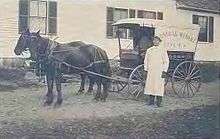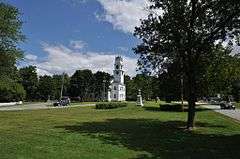Lyme, New Hampshire
| Lyme, New Hampshire | |
|---|---|
| Town | |
 Location in Grafton County, New Hampshire | |
| Coordinates: 43°48′37″N 72°09′22″W / 43.81028°N 72.15611°WCoordinates: 43°48′37″N 72°09′22″W / 43.81028°N 72.15611°W | |
| Country | United States |
| State | New Hampshire |
| County | Grafton |
| Incorporated | 1761 |
| Government | |
| • Board of Selectmen |
Susan J. MacKenzie, Chair Patricia G. Jenks Charles J. Smith |
| Area | |
| • Total | 54.7 sq mi (141.7 km2) |
| • Land | 53.8 sq mi (139.4 km2) |
| • Water | 0.9 sq mi (2.3 km2) 1.62% |
| Elevation | 548 ft (167 m) |
| Population (2010) | |
| • Total | 1,716 |
| • Estimate (2015) | 1,680 |
| • Density | 31/sq mi (12.0/km2) |
| Time zone | Eastern (UTC-5) |
| • Summer (DST) | Eastern (UTC-4) |
| ZIP code | 03768, 03769 |
| Area code(s) | 603 |
| FIPS code | 33-44260 |
| GNIS feature ID | 0873654 |
| Website |
www |
Lyme is a town along the Connecticut River in Grafton County, New Hampshire, United States. The population was 1,716 as of the 2010 census,[1] with an estimated population of 1,680 in 2015.[2] Lyme is home to the Chaffee Natural Conservation Area. The Dartmouth Skiway is in the eastern part of town, near the village of Lyme Center. The Appalachian Trail passes through the town's heavily wooded eastern end.
History

Photo: Lyme Historians
This was once a home to Abenaki Indians, including a band of Sokokis near Post Pond at a place they called Ordanakis. Later, it would be another of many towns granted by Colonial Governor Benning Wentworth along the Connecticut River in 1761. Many of the 63 grantees lived in Massachusetts and Connecticut, but virtually none of them ever settled in Lyme; they sold or assigned their grants to others. However, those settlers who did arrive in 1764 were mostly from those states.[3]:50-51 In the late 1770s, the town petitioned (ultimately unsuccessfully) to join Vermont.
The scenic town common is surrounded with houses and public buildings dating from the late 1700s to the early 1900s. Stagecoaches traveling the old "Boston Turnpike" from Montreal in the 1830s passed through Lyme, stopping at the Lyme Inn (recently renovated), built in 1809.[3]:96 Next door to the inn is the 200-year-old Congregational Church. Its original 1815 steeple bell[3]:309 was cast by Paul Revere. It was later replaced with a bell cast by Henry N. Cooper & Co., Boston. A hand-wound clock mechanism from E. Howard & Co. strikes the hour. Behind the church is a row of horse sheds dating from 1810 - the longest surviving row of horse sheds in New England.[3]:195 Originally each shed had the name of the owner on a sign above the door. The signs are still there, though not necessarily over the original shed.
Geography
According to the United States Census Bureau, the town has a total area of 54.7 square miles (141.7 km2), of which 53.8 square miles (139.3 km2) is land and 0.9 square miles (2.3 km2) is water, comprising 1.62% of the town.[4] Lyme is drained by Hewes, Grant and Trout brooks, all flowing to the Connecticut River, which forms the western boundary of the town (and of the state of New Hampshire).
The Lyme Common occupies the center of the village of Lyme, located about 1.5 miles (2.4 km) east of the Connecticut River.
Lyme is a rural town. Most human development is in the western half of the town along the Connecticut River and New Hampshire Route 10, known as the Dartmouth College Highway. The eastern half of the town is mostly forest. The town is home to four great ponds: Post Pond, Pout Pond, Trout Pond, and Reservoir Pond. Holts Ledge is a cliff that faces east and is part of the Dartmouth Skiway. The edge of the cliff is fenced to protect falcons. The highest point in town is the summit of Smarts Mountain, at 3,238 feet (987 m) above sea level. The Appalachian Trail crosses the summits of Holts Ledge and Smarts Mountain.
Demographics
| Historical population | |||
|---|---|---|---|
| Census | Pop. | %± | |
| 1790 | 816 | — | |
| 1800 | 1,318 | 61.5% | |
| 1810 | 1,670 | 26.7% | |
| 1820 | 1,824 | 9.2% | |
| 1830 | 1,804 | −1.1% | |
| 1840 | 1,785 | −1.1% | |
| 1850 | 1,617 | −9.4% | |
| 1860 | 1,572 | −2.8% | |
| 1870 | 1,358 | −13.6% | |
| 1880 | 1,313 | −3.3% | |
| 1890 | 1,154 | −12.1% | |
| 1900 | 1,080 | −6.4% | |
| 1910 | 1,007 | −6.8% | |
| 1920 | 891 | −11.5% | |
| 1930 | 830 | −6.8% | |
| 1940 | 965 | 16.3% | |
| 1950 | 924 | −4.2% | |
| 1960 | 1,026 | 11.0% | |
| 1970 | 1,112 | 8.4% | |
| 1980 | 1,289 | 15.9% | |
| 1990 | 1,496 | 16.1% | |
| 2000 | 1,679 | 12.2% | |
| 2010 | 1,716 | 2.2% | |
| Est. 2015 | 1,680 | [2] | −2.1% |

As of the census of 2010, there were 1,716 people, 705 households, and 503 families residing in the town. The population density was 31.4 people per square mile (12.1/km²). There were 810 housing units at an average density of 14.8 per square mile (5.7/km²). The racial makeup of the town was 96.9% White, 0.3% African American, 0.3% Native American, 1.1% Asian, 0.3% some other race, and 1.0% from two or more races. Hispanic or Latino of any race were 2.4% of the population.[6]

Photo: Lyme Historians
Of the 705 households 28.5% had children under the age of 18 living with them, 61.3% were headed by married couples living together, 6.5% had a female householder with no husband present, and 28.7% were non-families. 23.5% of all households were made up of householders living alone, and 9.0% were someone living alone who was 65 years of age or older. The average household size was 2.42, and the average family size was 2.86.[6]
In the town the population was spread out with 22.4% under the age of 18, 4.1% from 18 to 24, 19.5% from 25 to 44, 36.3% from 45 to 64, and 17.8% who were 65 years of age or older. The median age was 47.4 years. For every 100 females there were 95.4 males. For every 100 females age 18 and over, there were 93.4 males.[6]
Looking at the occupations of employed people in the town over the age of 16, the largest group - 50.9% - is education and health care. The next largest group - 9.6% - is professional, scientific, and management. Construction and manufacturing make up 8.4%; agriculture and forestry make up 0.7%.[7]
For the period 2010 through 2014 the estimated median annual income for a household in the town was $110,781, and the median income for a family was $130,795. Males working full-time, year-round had a median income of $101,875 versus $58,125 for females. The per capita income for the town was $68,381. About 0.6% of families and 3.1% of the population were below the poverty line, including 3.2% of those age 65 or over.[7]
Education
Lyme has two K-8 schools, one public and one independent.
There are currently around 200 students attending The Lyme School,[8] the public K-8 school. The school typically ranks in the top 5 - 10% of New Hampshire schools. Once a pupil reaches ninth grade, students from Lyme attend one of several high schools: Thetford Academy in Thetford, Vermont (across the Connecticut River), Hanover High School in Hanover, New Hampshire (about 10 miles south of Lyme), Hartford High School in Hartford, Vermont, Lebanon High School in Lebanon, New Hampshire, or St. Johnsbury Academy in St. Johnsbury, Vermont. Attendance is typically split between St. Johnsbury Academy, Thetford Academy and Hanover High, with the few remaining students going elsewhere.
Crossroads Academy[9] describes itself as "an independent, coeducational day school committed to academic excellence and moral integrity." It states its mission is to "inspire our students to love learning, act honorably, and contribute actively to intellectual, cultural, and civic life.” Founded in 1991 as a K-3 school in Hanover, New Hampshire, Crossroads Academy is now located on a wooded 140-acre campus at 95 Dartmouth College Highway in Lyme. It serves more than 130 students from a 50-mile radius in grades K-8 and employs 36 faculty and staff.
Sites of interest
Notable people
- Fred Hovey Allen, clergyman, author, and pioneer in American art reproduction
- Jonathan Child, first mayor of Rochester, New York
- David Marston Clough, 13th governor of Minnesota
- Marquis Converse, founder of Converse Rubber Shoe Company
- Amos P. Cutting, architect
- Trina Schart Hyman, illustrator of children's books
- Arthur Latham Perry, economist
- Baxter E. Perry, second mayor of Medford, Massachusetts
- Adm. Albert Cushing Read, commanded first trans-Atlantic seaplane flight (1919)
References
- ↑ "Geographic Identifiers: 2010 Demographic Profile Data (G001): Lyme town, Grafton County, New Hampshire". American Factfinder. U.S. Census Bureau. Retrieved August 24, 2016.
- 1 2 "Annual Estimates of the Resident Population for Incorporated Places: April 1, 2010 to July 1, 2015". Retrieved July 2, 2016.
- 1 2 3 4 Cole, Luane, ed. Patterns and Pieces 1761/1976. Phoenix Publishing: Canaan, NH. 1976
- ↑ "Geographic Identifiers: 2010 Demographic Profile Data (G001) - Lyme town, New Hampshire". American Factfinder. U.S. Census Bureau. Retrieved November 13, 2011.
- ↑ "Census of Population and Housing". Census.gov. Retrieved June 4, 2016.
- 1 2 3 "Profile of General Population and Housing Characteristics: 2010 Census Summary File 1 (DP-1): Lyme town, Grafton County, New Hampshire". American Factfinder. U.S. Census Bureau. Retrieved October 3, 2016.
- 1 2 "Selected Economic Characteristics: 2010-2014 American Community Survey 5-Year Estimates (DP03): Lyme town, Grafton County, New Hampshire". American Factfinder. U.S. Census Bureau. Retrieved October 3, 2016.
- ↑ The Lyme School,
- ↑ Crossroads Academy
External links
| Wikimedia Commons has media related to Lyme, New Hampshire. |
- Town of Lyme official website
- New Hampshire Economic and Labor Market Information Bureau Profile
- Converse Free Library
- Lyme Historians
- Dartmouth Skiway
- The Lyme School
- Crossroads Academy
